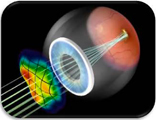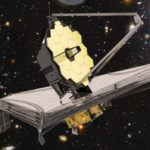NASA’s James Webb Space Telescope is scheduled to launch in 2021. It will incorporate advanced LASIK technology to help improve its optical systems in order to peer more deeply and more accurately into the far universe once in orbit. At the core of the James Webb Space Telescope’s optics are highly polished mirrors with incredibly precise tolerances. In order to maximize the optical quality of these mirrors, NASA technicians use a measurement sytems based on Hartmann Shack wavefront sensors, a technology I use on a daily basis when performing customized wavefront LASIK and PRK. With these laser eye surgeries for vision correction, an invisible and harmless infrared measurement laser is shined into the patient’s eye and bounced off the retina in the back of the eye. The reflected infrared laser light comes back through the eye as a returning “wavefront” of infrared light. As this infrared wavefront travels from the back of the eye all the way to the front and ultimately out of the eye, it is distorted by all the nuances of that person’s eye’s optics. When the distorted wave of infrared light leaves the eye (called the “optical fingerprint”), it is measured by a grid of sensors, the same Hartmann Shack sensors that NASA is using. These sensors can determine the angle at which the infrared light rays are coming toward them and provide information on how the cornea needs to be reshaped to optimize the patient’s vision with an accuracy that far exceeds the normal “which is better one or two test”. NASA is using a similar system, based on Hartmann Shack sensor measurements, to guide the polishing of the space telescopes mirrors to refine the optics to a degree which is impossible without wavefront technology. In a way, NASA is performing customized wavefront surgery on their most advanced telescope!
Customized Wavefront Optical Mapping As Used In LASIK Laser Eye Surgery — And By NASA
James Webb Space Telescope’s Mirrors Undergoing Construction at NASA
Artist Rendition Of James Webb Space Telescope In Orbit, Peering Deep Into The Universe




